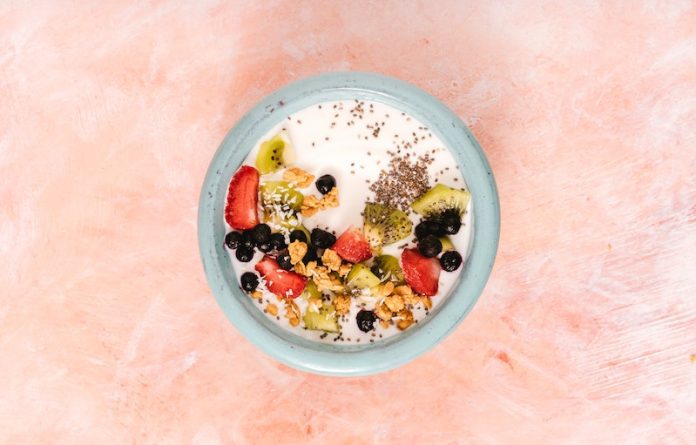
Half of all Americans have high blood pressure, also known as hypertension, and many don’t even know they have it.
High blood pressure develops when blood flows through your arteries at higher-than-normal pressures. Your blood pressure is made up of two numbers: systolic and diastolic.
Systolic pressure is the pressure when the ventricles pump blood out of the heart. Diastolic pressure is the pressure between heartbeats when the heart is filling with blood.
Your blood pressure changes throughout the day based on your activities.
For most adults, normal blood pressure is less than 120 over 80 millimeters of mercury (mm Hg), which is written as your systolic pressure reading over your diastolic pressure reading — 120/80 mm Hg.
Your blood pressure is considered high when you have consistent systolic readings of 130 mm Hg or higher or diastolic readings of 80 mm Hg or higher.
Recent studies showed that healthy foods and diets could help lower high blood pressure.
Dairy foods and blood pressure
In a recent study by McMaster University and elsewhere, researchers found that drinking milk is linked to a lower risk of diabetes and hypertension.
They found a link between consuming a higher amount of dairy— especially whole-fat foods—and lower rates of high blood pressure and diabetes.
The findings dispel the myth that reduced-fat foods are healthier than whole-fat foods.
In the study, researchers examined nearly 150,000 people from 21 countries, including Africa, Asia, Europe, and North and South America. The age of participants varied, ranging from 35 to 70.
They used questionnaires to learn about participants’ food consumption throughout the year.
Those in the study outlined how many times they ate specific items from the list, which included dairies such as milk, yogurt, cheese, and meals made with dairy.
In addition, dairy products were classified as whole-fat or low-fat.
The team followed up with participants for about 9 years and found there is an association of a 24% lower risk of metabolic syndrome, which is a group of symptoms that increase the risk of heart disease.
That lowered risk was tied to having a minimum of two servings of dairy per day compared to eating no dairy.
The team also found that consuming whole-fat dairy had a stronger association with low-fat dairy with lowering the risk of diabetes and high blood pressure.
But having at least two servings of any dairy product was linked to a lower risk of having the health conditions.
The team says a higher intake of dairy foods, such as milk, yogurt, and cheese, especially whole-fat dairy rather than low-fat dairy, is linked to a lower risk of metabolic syndrome and a lower risk of developing high blood pressure and diabetes.
The study was published in BMJ Open Diabetes Research & Care.
Fruits and high blood pressure
In another study from Queen’s University, scientists found that flavonoid-rich foods, including berries, apples, pears, and wine, appear to have a positive effect on blood pressure levels.
Flavonoids are compounds found naturally in fruits, vegetables, and plant-based foods such as tea, chocolate, and wine. Flavonoids are broken down by the body’s gut microbiome—the bacteria found in the digestive tract.
In the study, researchers found people who had the highest intake of flavonoid-rich foods had lower systolic blood pressure levels, as well as greater diversity in their gut microbiome.
Eating 1.6 servings of berries per day (one serving equals 80 grams or 1 cup) was linked to an average reduction in systolic blood pressure levels of 4.1 mm Hg, and about 12% of the association was explained by the gut microbiome.
Drinking 2.8 glasses (125 ml of wine per glass) of red wine a week was linked to an average of 3.7 mm Hg lower systolic blood pressure level, of which 15% could be explained by the gut microbiome.
The findings suggest these blood-pressure-lowering effects are achievable with simple changes to the daily diet.
The study was published in Hypertension.
Whole grains and blood pressure
In another study, Tufts researchers found adults who ate at least three servings of whole grains daily had smaller increases in waist size, blood pressure, and blood sugar levels.
They examined how whole- and refined-grain intake over time impacted five risk factors of heart disease: Waist size, blood pressure, blood sugar, triglyceride, and HDL (“good”) cholesterol.
The researchers focused on health outcomes linked to whole- and refined-grain consumption over 18 years in 3,100 participants.
They found that waist size increased by an average of over 1 inch in the low intake participants, versus about ½ inch in the high intake participants.
The average increases in blood sugar levels and systolic blood pressure were greater in low-intake participants compared to high-intake participants.
The researchers also found lower refined-grain intake led to a lower average increase in waist size and a greater mean decline in triglyceride levels for each four-year period.
The study was published in the Journal of Nutrition.
Mediterranean diet and high blood pressure
Scientists from the University of Maine found that eating a diet similar to the Mediterranean diet is linked to lower blood pressure among U.S. adults.
The Mediterranean diet has been linked to a range of health benefits, including anti-inflammatory properties.
In the study, researchers examined the link between adherence to a Mediterranean diet and blood pressure in a sample of older (average age 62.2 years) women and men living in the United States.
They found strong links between higher levels of the Mediterranean diet and lower levels of systolic and diastolic blood pressure among those who consumed higher amounts of Mediterranean diet foods.
The team says the lowering of blood pressure by this amount is important in terms of the U.S. population as a whole.
Indeed, it’s been determined that lowering systolic blood pressure by even 2mmHg at the population level reduced heart disease by 10%.
The research is published in the Journal of Clinical Hypertension and was conducted by Fayeza Ahmed et al.
Diet high in omega-3 fats and high blood pressure
Scientists recently found that healthy young people may be able to help prevent high blood pressure by eating diets rich in omega-3 fatty acids.
Omega-3 fatty acids are essential fats, mostly found in fish and some types of plant oils.
In the study, researchers studied 2,036 young, healthy adults by measuring the amount of omega-3 fatty acids in their blood and recording their blood pressure measurements.
They divided people into four groups, from the quarter with the highest amount of omega-3 fatty acids in their blood to the quarter with the lowest.
The team found adults in the highest quarter had about 4 mm Hg lower systolic and 2 mm Hg lower diastolic blood pressure compared to those with the least omega-3 fatty acids in their blood.
In general, the higher the omega-3 fatty acids in the blood meant lower both systolic and diastolic blood pressure.
This suggests promoting diets rich in omega-3 foods could become a strategy to prevent high blood pressure.
The study was presented at the American Heart Association’s Scientific Sessions.
A plant-based diet and high blood pressure
In two recent studies from the Medical College of Georgia, researchers found that a plant-based diet may effectively prevent high blood pressure.
They found the diet may also protect against deadly preeclampsia in pregnancy.
Preeclampsia is a potentially lethal problem during pregnancy where the mother’s blood pressure, which typically was normal before, soars and organs like the kidneys and liver show signs of damage.
The findings provide more evidence that the gut microbiota, which contains trillions of microorganisms that help us digest food and play a key role in regulating the response of our immune system, is also a player in the unhealthy response to salt.
In the study, researchers hypothesized that dietary alterations shift the microbiota to mediate the development of salt-sensitive high blood pressure and renal disease.
The gut microbiome is designed to metabolize what we eat, break it down, and put it in a form that gives us nutrition, and reciprocally it reflects what we eat.
The team found animal protein in a diet can amplify the effects of salt.
Rats on a milk-based protein diet developed renal damage and inflammation—both indicators of high blood pressure. On the other hand, rats on a grain-based diet had much fewer of these unhealthy results.
When the team gave the protected rats some of the distinctive gut microbiota from the sick rats, via fecal transplant, the rats experienced increases in blood pressure and kidney damage. It also changed the composition of their gut microbiota.
In another experiment, the team found a diet high in animal protein can trigger the development of preeclampsia, while a plant-based diet reduces the risk.
The team says high blood pressure is the largest modifiable risk factor for the development of heart disease. According to the newest guidelines from groups like the American Heart Association, nearly half of us are hypertensive.
Diet—including a high-salt diet—is one of the top modifiable risk factors for high blood pressure and heart disease.
The study findings were published in ACTA PHYSIOLOGICA.
Copyright © 2022 Scientific Diet. All rights reserved.








